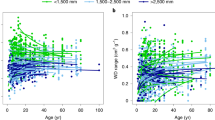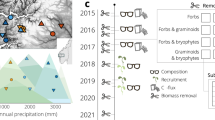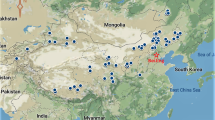Abstract
Woody plants (shrubs and trees) are encroaching across the globe, affecting livestock production and terrestrial ecosystem functioning. Despite the widespread practice, there has been no quantitative global assessment of whether removal of encroaching woody plants will re-instate productive grasslands and open savanna. Here we compiled a global database of 12,198 records from 524 studies on the ecosystem responses of both the encroachment and removal of woody plants, and show that removal fails to reverse encroachment impacts. Removing woody plants only reversed less than half of the reductions in herbaceous structure induced by encroachment, and woody expansion actually enhanced ecosystem functions (+8%). The effectiveness of removal varied with encroachment stage (that is, time since treatment) and the functional traits (for example, deciduousness and resprouting) of the focal woody species, and waned in drier regions. Our results suggest that assessment of woody plant communities before removal is critical to assess the likelihood of successful ecosystem recovery.
This is a preview of subscription content, access via your institution
Access options
Access Nature and 54 other Nature Portfolio journals
Get Nature+, our best-value online-access subscription
$29.99 / 30 days
cancel any time
Subscribe to this journal
Receive 12 digital issues and online access to articles
$119.00 per year
only $9.92 per issue
Buy this article
- Purchase on Springer Link
- Instant access to full article PDF
Prices may be subject to local taxes which are calculated during checkout





Similar content being viewed by others
Data availability
All the materials, raw data and protocols used in the article are available upon request and without restriction. The meta-analysis database is available in figshare repository (https://doi.org/10.6084/m9.figshare.19915300.v2). Source data are provided with this paper.
References
Deng, Y., Li, X., Shi, F. & Hu, X. Woody plant encroachment enhanced global vegetation greening and ecosystem water-use efficiency. Glob. Ecol. Biogeogr. 30, 2337–2353 (2021).
Brandt, J., Haynes, M., Kuemmerle, T., Waller, D. & Radeloff, V. Regime shift on the roof of the world: alpine meadows converting to shrublands in the southern Himalayas. Biol. Conserv. 158, 116–127 (2013).
García Criado, M., Myers-Smith, I. H., Bjorkman, A. D., Lehmann, C. E. R. & Stevens, N. Woody plant encroachment intensifies under climate change across tundra and savanna biomes. Glob. Ecol. Biogeogr. 29, 925–943 (2020).
van Auken, O. Causes and consequences of woody plant encroachment into western North American grasslands. J. Environ. Manage. 90, 2931–2942 (2009).
Bond, W. J., Midgley, G. F. & Woodward, F. I. The importance of low atmospheric CO2 and fire in promoting the spread of grasslands and savannas. Glob. Chang. Biol. 9, 973–982 (2010).
D’Odorico, P., Okin, G. S. & Bestelmeyer, B. T. A synthetic review of feedbacks and drivers of shrub encroachment in arid grasslands. Ecohydrology 5, 520–530 (2012).
Kulmatiski, A. & Beard, K. H. Woody plant encroachment facilitated by increased precipitation intensity. Nat. Clim. Change 3, 833–837 (2013).
Eldridge, D. J. & Soliveres, S. Are shrubs really a sign of declining ecosystem function? Disentangling the myths and truths of woody encroachment in Australia. Aust. J. Bot. 62, 594–608 (2015).
Domine, F., Barrere, M. & Morin, S. The growth of shrubs on high Arctic tundra at Bylot Island: impact on snow physical properties and permafrost thermal regime. Biogeosciences 13, 6471–6486 (2016).
Maestre, F. T., Callaway, R. M., Valladares, F. & Lortie, C. J. Refining the stress-gradient hypothesis for competition and facilitation in plant communities. J. Ecol. 97, 199–205 (2009).
Eldridge, D. J. et al. Impacts of shrub encroachment on ecosystem structure and functioning: towards a global synthesis. Ecol. Lett. 14, 709–722 (2011).
Archer, S. R. & Predick, K. I. An ecosystem services perspective on brush management: research priorities for competing land-use objectives. J. Ecol. 102, 1394–1407 (2014).
Eldridge, D. J. & Ding, J. Remove or retain: ecosystem effects of woody encroachment and removal are linked to plant structural and functional traits. N. Phytol. 229, 2637–2646 (2020).
Albrecht, M. A., Becknell, R. E. & Long, Q. Habitat change in insular grasslands: woody encroachment alters the population dynamics of a rare ecotonal plant. Biol. Conserv. 196, 93–102 (2016).
Stanton, R. A. et al. Shrub encroachment and vertebrate diversity: a global meta-analysis. Glob. Ecol. Biogeogr. 27, 368–379 (2017).
Archer, S. R. et al. in Rangeland Systems: Processes, Management and Challenges (ed. Briske, D.) 25–84 (Springer, 2017).
Anadón, J. D., Sala, O. E., Turner, B. L. & Bennett, E. M. Effect of woody-plant encroachment on livestock production in North and South America. Proc. Natl Acad. Sci. USA 111, 12948–12953 (2014).
Maestre, F. T. et al. Structure and functioning of dryland ecosystems in a changing world. Annu. Rev. Eco. Evol. Syst. 47, 215–237 (2016).
Teague, W. et al. Sustainable management strategies for mesquite rangeland: the Waggoner Kite project. Rangelands 19, 4–9 (1997).
Hamilton, W. T., McGinty, A., Ueckert, D. N., Hanselka, C. W. & Lee, M. R. Brush Management: Past, Present, Future (A&M Univ. Press, 2004).
Bestelmeyer, B. T. et al. The grassland–shrubland regime shift in the southwestern United States: misconceptions and their implications for management. BioScience 68, 678–690 (2018).
Ding, J. & Eldridge, D. J. Contrasting global effects of woody plant removal on ecosystem structure, function and composition. Perspect. Plant Ecol. Evol. Syst. 39, 125460 (2019).
Huxman, T. E. et al. Ecohydrological implication of woody plant encroachment. Ecology 86, 308–319 (2005).
Schmutz, E. M., Cable, D. R. & Warwick, J. J. Effect of shrub removal on the vegetation of a semidesert grass-shrub range. Rangel. Ecol. Manag. 12, 34–37 (1959).
Noble, J. C. & Walker, P. Integrated shrub management in semi-arid woodlands of eastern Australia: a systems-based decision support model. Agric. Syst. 88, 332–359 (2006).
Eldridge, D. J. et al. The pervasive and multifaceted influence of biocrusts on water in the world’s drylands. Glob. Chang. Biol. 26, 6003–6014 (2020).
Bestelmeyer, B. T., Goolsby, D. P. & Archer, S. R. Spatial perspectives in state-and-transition models: a missing link to land management. J. Appl. Ecol. 48, 746–757 (2011).
Riginos, C. & Young, T. P. Positive and negative effects of grass, cattle, and wild herbivores on Acacia saplings in an East African savanna. Oecologia 153, 985–995 (2007).
Soliveres, S. et al. Plant diversity and ecosystem multifunctionality peak at intermediate levels of woody cover in global drylands. Glob. Ecol. Biogeogr. 23, 1408–1416 (2014).
Soliveres, S. & Eldridge, D. J. Do changes in grazing pressure and the degree of shrub encroachment alter the effects of individual shrubs on understorey plant communities and soil function? Funct. Ecol. 28, 530–537 (2013).
Maestre, F. T., Bowker, M. A., Puche, M., Hinojosa, M. B. & Escudero, A. Shrub encroachment can reverse desertification in semi-arid Mediterranean grasslands. Ecol. Lett. 12, 930–941 (2010).
Abreu, R. C. R., Durigan, G., Melo, A. C. G., Pilon, N. A. L. & Hoffmann, W. A. Facilitation by isolated trees triggers woody encroachment and a biome shift at the savanna-forest transition. J. Appl. Ecol. 58, 2650–2660 (2021).
North, M., Oakley, B., Fiegener, R. & Barbour, G. M. Influence of light and soil moisture on Sierran mixed-conifer understory communities. Plant Ecol. 177, 13–24 (2005).
Muvengwi, J., Mbiba, M., Jimu, L., Mureva, A. & Dodzo, B. An assessment of the effectiveness of cut and ring barking as a method for control of invasive Acacia mearnsii in Nyanga National Park, Zimbabwe. For. Ecol. Manag. 427, 1–6 (2018).
Abella, S. R. & Chiquoine, L. P. The good with the bad: when ecological restoration facilitates native and non-native species. Restor. Ecol. 27, 343–351 (2019).
Bestelmeyer, B., Ward, J., Herrick, E. J. & Tugel, A. J. Fragmentation effects on soil aggregate stability in a patchy arid grassland. Rangel. Ecol. Manag. 59, 406–415 (2006).
Okin, G. S., Gillette, D. A. & Herrick, J. E. Multi-scale controls on and consequences of aeolian processes in landscape change in arid and semi-arid environments. J. Arid. Environ. 65, 253–275 (2006).
Hu, X., Li, X. Y., Zhao, Y., Gao, Z. & Zhao, S. J. Changes in soil microbial community during shrub encroachment process in the Inner Mongolia grassland of northern China. Catena 202, 105230 (2021).
D’Odorico, P. et al. Positive feedback between microclimate and shrub encroachment in the northern Chihuahuan desert. Ecosphere 1, 1–11 (2010).
Eldridge, D. J., Soliveres, S., Bowker, M. A. & Val, J. Grazing dampens the positive effects of shrub encroachment on ecosystem functions in a semi‐arid woodland. J. Appl. Ecol. 50, 1028–1038 (2013).
Daryanto, S., Eldridge, D. J. & Throop, H. L. Managing semi-arid woodlands for carbon storage: grazing and shrub effects on above- and belowground carbon. Agric. Ecosyst. Environ. 169, 1–11 (2013).
Paynter, Q. & Flanagan, G. J. Integrating herbicide and mechanical control treatments with fire and biological control to manage an invasive wetland shrub, Mimosa pigra. J. Appl. Ecol. 41, 615–629 (2004).
Throop, H. L., Reichmann, L. G., Sala, O. E. & Archer, S. R. Response of dominant grass and shrub species to water manipulation: an ecophysiological basis for shrub invasion in a Chihuahuan Desert grassland. Oecologia 169, 373–383 (2012).
Brantley, S. T. & Young, D. R. Shifts in litterfall and dominant nitrogen sources after expansion of shrub thickets. Oecologia 155, 337–345 (2008).
Ding, J. & Eldridge, D. J. The fertile island effect varies with aridity and plant patch type across an extensive continental gradient. Plant Soil 459, 173–183 (2020).
Mihoč, M. et al. Soil under nurse plants is always better than outside: a survey on soil amelioration by a complete guild of nurse plants across a long environmental gradient. Plant Soil 408, 31–41 (2016).
Ochoa-Hueso, R. et al. Soil fungal abundance and plant functional traits drive fertile island formation in global drylands. J. Ecol. 106, 242–253 (2018).
Soliveres, S., Eldridge, D. J., Hemmings, F. & Maestre, F. T. Nurse plant effects on plant species richness in drylands: the role of grazing, rainfall and species specificity. Perspect. Plant Ecol. Evol. Syst. 14, 402–410 (2012).
Schlesinger, W. et al. Biological feedbacks in global desertification. Science 147, 1043–1048 (1990).
Ding, J. & Eldridge, D. J. Climate and plants regulate the spatial variation in soil multifunctionality across a climatic gradient. Catena 201, 105233 (2021).
Ding, J., Travers, S. K., Delgado-Baquerizo, M. & Eldridge, D. J. Multiple trade-offs regulate the effects of woody plant removal on biodiversity and ecosystem functions in global rangelands. Glob. Chang. Biol. 26, 709–720 (2020).
De Soyza, A. G., Whitford, W. G., Martinez-Meza, E. & Van Zee, J. W. Variation in creosotebush (Larrea tridentata) canopy morphology in relation to habitat, soil fertility and associated annual plant communities. Am. Nat. 137, 13–26 (1997).
Breemen, N. V. Nutrient cycling strategies. Plant Soil 168, 321–326 (1995).
Li, J., Gilhooly, W. P. III., Okin, G. S. & Blackwell, J. III. Abiotic processes are insufficient for fertile island development: a 10-year artificial shrub experiment in a desert grassland. Geophys. Res. Lett. 44, 2245–2253 (2017).
Ward, D. et al. Large shrubs increase soil nutrients in a semi-arid savanna. Geoderma 310, 153–162 (2018).
Miwa, C. Persistence of Western Juniper Resource Islands following Canopy Removal. MSc thesis, Oregon State Univ. (2007).
Zhou, L. et al. Shrub-encroachment induced alterations in input chemistry and soil microbial community affect topsoil organic carbon in an Inner Mongolian grassland. Biogeochemistry 136, 311–324 (2017).
Kwok, A. B. C. & Eldridge, D. J. The influence of shrub species and fine-scale plant density on arthropods in a semiarid shrubland. Rangel. J. 38, 381–389 (2016).
Young, J. A., Evans, R. A. & Rimbey, C. Weed control and revegetation following western juniper (Juniperus occidentalis) control. Weed Sci. 33, 513–517 (1985).
Wiedemann, H. T. & Kelly, P. J. Turpentine (Eremophila sturtii) control by mechanical uprooting. Rangel. J. 23, 173–181 (2001).
Bowker, M. A., Belnap, J., Chaudhary, V. B. & Johnson, N. C. Revisiting classic water erosion models in drylands: the strong impact of biological soil crusts. Soil Biol. Biochem. 40, 2309–2316 (2008).
Ding, J. & Eldridge, D. J. Biotic and abiotic effects on biocrust cover vary with microsite along an extensive aridity gradient. Plant Soil 450, 429–441 (2020).
Blaum, N., Seymour, C., Rossmanith, E., Schwager, M. & Jeltsch, F. Changes in arthropod diversity along a land use driven gradient of shrub cover in savanna rangelands: identification of suitable indicators. Biodivers. Conserv. 18, 1187–1199 (2009).
Eldridge, D. J., Poore, A., Ruiz-Colmenero, M., Letnic, M. & Soliveres, S. Ecosystem structure, function and composition in rangelands are negatively affected by livestock grazing. Ecol. Appl. 26, 1273–1283 (2016).
Maestre, F. T. & Cortina, J. Insights into ecosystem composition and function in a sequence of degraded semiarid steppes. Restor. Ecol. 12, 494–502 (2004).
Nakagawa, S. in Ecological Statistics: Contemporary Theory and Application (eds Fox, G. A. et al.) Ch. 4 (Oxford Univ. Press, 2015).
Fick, S. E. & Hijmans, R. J. WorldClim 2: new 1-km spatial resolution climate surfaces for global land areas. Int. J. Climatol. 37, 4302–4315 (2017).
Zomer, R. J., Trabucco, A., Bossio, D. A. & Verchot, L. V. Climate change mitigation: a spatial analysis of global land suitability for clean development mechanism afforestation and reforestation. Agric. Ecosyst. Environ. 126, 67–80 (2008).
Tavşanoğlu, Ç. & Pausas, J. G. A functional trait database for mediterranean basin plants. Sci. Data 5, 180135 (2018).
The PLANTS Database (USDA, 2019); https://plants.usda.gov/
Kattge, J. et al. TRY—a global database of plant traits. Glob. Chang. Biol. 17, 2905–2935 (2011).
Hedges, L. V., Gurevitch, J. & Curtis, P. S. The meta-analysis of response ratios in experimental ecology. Ecology 80, 1150–1156 (1999).
Mallen-Cooper, M. et al. Global synthesis reveals strong multifaceted effects of eucalypts on soils. Glob. Ecol. Biogeogr. 31, 1667–1678 (2022).
Chen, X., Chen, H. Y. & Chang, S. X. Meta-analysis shows that plant mixtures increase soil phosphorus availability and plant productivity in diverse ecosystems. Nat. Ecol. Evol. 6, 1112–1121 (2022).
Noble, D. W. A., Lagisz, M., O’dea, R. E. & Nakagawa, S. Nonindependence and sensitivity analyses in ecological and evolutionary meta-analyses. Mol. Ecol. 26, 2410–2425 (2017).
Nakagawa, S. & Santos, E. Methodological issues and advances in biological meta-analysis. Ecol. Evol. 26, 1253–1274 (2012).
Grace, J. B. Structural Equation Modeling and Natural Systems (Cambridge Univ. Press, 2006).
Viechtbauer, W. Conducting meta-analyses in R with the metafor package. J. Stat. Softw. 36, 1–48 (2010).
Archer, E. rfPermute v2.1.1 (R Foundation for Statistical Computing, 2010).
Wickham, H. ggplot2: Elegant Graphics for Data Analysis (Springer, 2009).
Stefan, V. & Levin, S. plotbiomes: plot Whittaker biomes with ggplot2 (R package version 0009001, 2021).
Kahle, D. & Wickham, H. ggmap: spatial visualization with ggplot2. R. J. 5, 144–161 (2013).
R Core Team. MOSR connections (R Foundation for Statistical Computing, 2013).
Acknowledgements
We thank B. Fu and S. Soliveres for their valuable comments on the original draft, S. Nakagawa and M. Mallen-Cooper for assistance with the meta-analysis, and M. García Criado for constructive comments during the peer review process. This research is funded by the Third Xinjiang Scientific Expedition Program (grant no. 2022xjkk0405 to J.D.), National Natural Science Foundation of China Project (grant nos. 32201324 and 41991232 to J.D.), the Fundamental Research Funds for the Central Universities (to J.D.), State Key Laboratory of Earth Surface Processes and Resource Ecology (2022-TS-02 to J.D.) and the Hermon Slade Foundation (to D.E.).
Author information
Authors and Affiliations
Contributions
D.E. and J.D. designed the research, collected data and built the databases. J.D. performed the statistical analyses and wrote the first draft. D.E. critically revised the manuscript.
Corresponding author
Ethics declarations
Competing interests
The authors declare no competing interests
Peer review
Peer review information
Nature Plants thanks Zhengbing Yan and Mariana García Criado for their contribution to the peer review of this work.
Additional information
Publisher’s note Springer Nature remains neutral with regard to jurisdictional claims in published maps and institutional affiliations.
Supplementary information
Supplementary Information
Supplementary Figs. 1–5, Tables 1–10 and Appendices 1–4.
Supplementary Tables 1 and 2
Tables for supporting Supplementary Figs. 3–4.
Source data
Source Data Fig. 1
Source data (map coordinates) for Fig. 1 in main text.
Source Data Fig. 2
Source data for Fig. 2 in main text.
Source Data Fig. 3
Source data for panels a–c for Fig. 3 in main text.
Source Data Fig. 4
Source data for panels a–d for Fig. 4 in main text.
Source Data Fig. 5
Source data for all panels for Fig. 5 in main text.
Rights and permissions
About this article
Cite this article
Ding, J., Eldridge, D. The success of woody plant removal depends on encroachment stage and plant traits. Nat. Plants 9, 58–67 (2023). https://doi.org/10.1038/s41477-022-01307-7
Received:
Accepted:
Published:
Issue Date:
DOI: https://doi.org/10.1038/s41477-022-01307-7
This article is cited by
-
Slope aspect of a mountainous grassland landscape shapes the structure of an encroaching shrub (Euryops floribundus N.E. Br): insights from communal grazing sites located at varying distances from rural homesteads
Community Ecology (2024)
-
Plant succession and geo-topography determined forest soil P and nine fraction-Ps across a larch forest chronosequence in the northmost region of China
Plant and Soil (2023)



